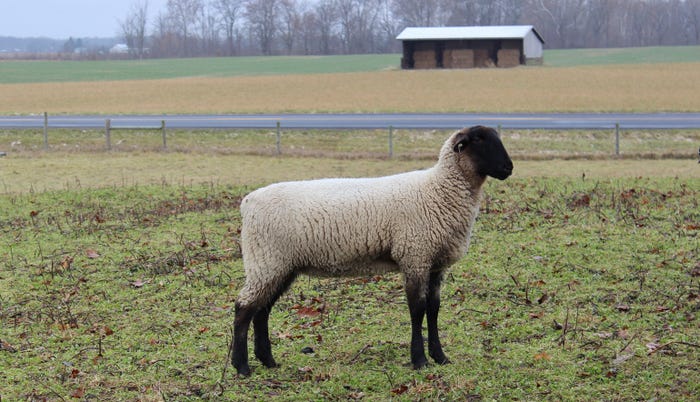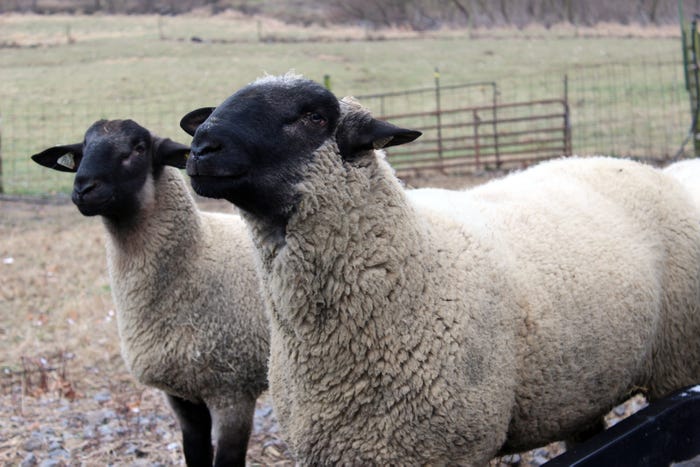
Old photos on the office wall at Bunker Hill Farm show the Shultz family’s history of success in breeding and showing high-quality sheep. For most of the farm’s history, visual appraisals guided selection and breeding programs, but these days Bill Shultz and his wife, Susan, would rather rely on estimated breeding values (EBVs). Visual appraisals are still useful to spot lambs with disqualifying defects, but looks can be deceiving when evaluating growth rates, fat thickness and muscle quality, explains Susan. “The one that’s a beauty queen might be a single that likes to eat a lot.”
The Shultzes have been raising sheep on their Logan County, Ohio, farm since the 1930s. When Bill and Susan joined the operation in the late 1970s, they continued the tradition by developing a nationally recognized Rambouillet flock. More recently, they’ve been working on genetic improvement of their Suffolk flock to provide seedstock for the commercial market. In particular, they’re working to produce rams that will sire fast-growing, heavily muscled lambs that will thrive in grain-based feedlot finishing systems. “We want lambs that will get there fast without getting fat,” explains Bill.

OUTWARD APPEARANCE: Visual appraisals still help Bill and Susan Shultz eliminate sheep with defects from their breeding pool, but estimated breeding values (EBVs) are more useful in evaluating potential.

To identify animals that are genetically superior, Bill and Susan collect data on each lamb born on their farm and compare it with data from other producers though the National Sheep Improvement Program (NSIP). Each lamb is weighed three times: at birth, weaning and postweaning. They favor moderate birth weights, since smaller lambs can be too weak to thrive and larger ones can cause lambing difficulties. Weaning weights, taken at about 60 days, are a good indicator of early growth. Postweaning weights, taken at about 120 days, are indicators of overall growth. They also do ultrasound scans of lambs at 120 days to evaluate rib-eye muscle size and fat thickness. However, Susan points out, “Raw data has limited value when compared to breeding values.”
To be useful, the data need to be analyzed through the NSIP program, which compiles data from many breeders and figures in data from related animals. To get an accurate picture of a flock’s genetic makeup, it’s important to collect a complete set of data on every lamb, Bill says.
The genetic potential of animals in small flocks can be harder to evaluate, especially if the flocks have isolated genetics. Having genetic links with other flocks creates a larger data pool, explains Bill. Sharing genetics and working together with other producers makes EBVs more accurate, so genetic improvement can be made more quickly.
To evaluate the accuracy of EBVs for high growth and for muscle depth, Bill has been working with a group of Western sheep producers on a production trial comparing about 1,500 lambs with different genetics. He is supplying some of the sires used for the trial. The lambs were born in Utah and spent the summer on pasture; they were weaned in early fall and sent to a feedlot in Idaho. Their carcasses will be evaluated after they are slaughtered in February or March. The research also includes DNA analysis of tissue samples to help match genes with specific traits.

GENETIC ADVANTAGE: The ram in the foreground has a gene variation that results in growth of more muscle cells. The gene originated in the Texel breed, and Bill Shultz is introducing it into the Suffolk breed.

Genomic information is currently being used to identify single gene traits affecting animal health issues such as scrapie, spider syndrome, and ovine progressive pneumonia. The future in DNA analysis lies in identifying performance traits that are often controlled by multiple genes, says Bill.
The first step is linking a gene with performance characteristics. For instance, a gene responsible for myostatin has also been shown to affect muscle development in sheep, Bill explains. “Genomics has allowed us to find it.” That gene variation, which results in growth of more muscle cells, has been identified in the Texel breed. Bill is working on introducing the gene into the Suffolk breed. To be considered a purebred Suffolk, a sheep must have 15/16 Suffolk parentage, so introducing the gene will require four generations of crossbreeding — but DNA analysis allows breeders to quickly identify lambs with the gene.
Expanding lamb markets with cooperative efforts
Experienced sheep producers can tell a lot about lambs by looking at them, but outward appearance isn’t the most accurate method of evaluating meat quality and genetic potential. To select the best lambs for specific markets and production environments, some Ohio producers are taking a closer look at their lambs with performance data comparisons and ultrasound scans. Those tools can help producers improve production efficiency and produce more consistent, high-quality meat, explains lamb producer Laura DeYoung Minnig. “You can’t manage what you can’t measure,” she points out.
Minnig has been raising Dorset sheep at The Spicy Lamb Farm near Peninsula, Ohio, for 11 years, and she sees potential for increasing sales of Ohio lamb within the state. Currently many Ohio lambs are sold through stockyard auctions and shipped out of state for processing. Meanwhile, most lamb consumed in Ohio is imported from Australia or New Zealand. One reason is that the quality of Ohio lamb is inconsistent because of the variety in genetics and management practices, she says. The average-size flock in Ohio is 40 ewes, and a restaurant might need 500 uniform lambs to put lamb on the menu, she explains. To meet that market demand, producers will need to work together to produce consistent lambs.
As one of the organizers of the North Coast Lamb Co-op, Minnig has been studying the use of loin-eye ultrasound scanning to help identify lambs with uniform carcasses. The co-op’s goal is to market lamb from member farms directly to groceries and restaurants. The ultrasound research, partially funded with a Sustainable Agriculture Research and Education (SARE) grant, demonstrated the use of ultrasound scanning to measure loin-eye muscle and fat depth for selecting breeding stock and for marketing uniform meat.
One quality problem with Ohio-raised lamb is excessive fat at slaughter, says Minnig. Increasing muscling also has the potential to increase the value of the lamb. While some existing sheep producers are satisfied with seasonal production and marketing lambs through stockyards, the market for local lamb could offer better returns, she explains. However, filling the local demand will require a year-round supply of fresh lamb and more consistent meat.
Keck writes from Raymond, Ohio.
About the Author(s)
You May Also Like




